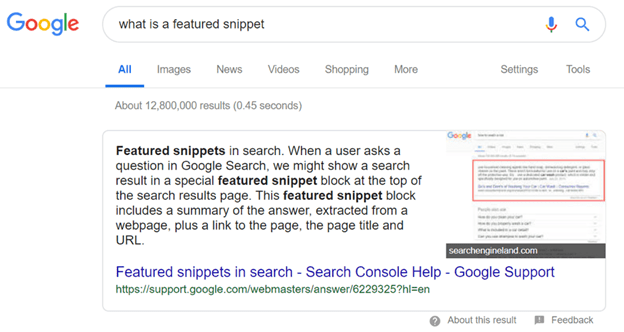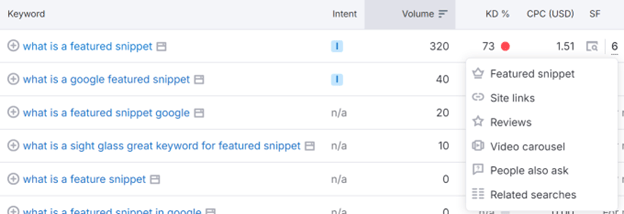Featured snippets. You know them, even if you don’t know them by name.
They’re ubiquitous in Google searches — although not all (more on what queries bring them up in a moment) — and can give those featured a huge boost.
By understanding the mechanisms behind featured snippets and optimizing for them, you can significantly increase not just your visibility, but all the downstream effects of that — including click-through rates and more that are the foundation for greater staying power and sales.
Understanding featured snippets
First off:
What they are and why they matter
Featured snippets are exactly what they sound like: highlighted bits of content that Google features near the top of their search engine results page to give a basic, quick answer to the focus of the query.

These matter because, in an ecosystem where attention spans are shorter than ever, being the most accessible search result — and the most implicitly authoritative — give you a massive leg up in gaining eyes and trust.
Not only are featured snippets one of the first things shown on a search engine results page, drawing in users’ attention, but they are often perceived as especially authoritative due to their positioning, succinctness, and the fact that they’ve been “chosen” by Google. Furthermore, they appear most often for searches that are asking for something specific from the search, meaning you know these users are actively looking for the specifics of what a featured snippet can teach them. This tends to lead to higher click-through rates from users who come from a featured snippet.
What type of content is most likely to be a snippet?
To understand what’s most likely to be featured in a snippet, you have to look at A) their purpose and B) their parameters: i.e., A) to provide a user with a summary of what they’re apparently looking for, and B) be concise enough that it is digestible and fits within the limited space.
Essentially: Be clear, be concise.
This leads to the following being extremely good candidates for featured snippets:
- Content with clear, concise answers to common questions
- Content defining terms or concepts in a straightforward manner
- Informative lists
- Step-by-step guides or tutorials answering “how to” queries
- Data presented in table format, for example pricing, statistics, and other comparisons
- FAQs with direct, brief-but-clear answers
So, how do you get from this foundational knowledge on what makes a featured snippet, to understanding where there are queries that need them?
Identifying opportunities for featured snippets
While “what you make” is crucial for getting highlighted as a featured snippet, “which queries need featured snippets” is a very productive line of thought to support that.
So, once you’ve identified some of your areas of expertise that you could address in clear, direct ways, you can work extra smart by finding keywords that will trigger featured snippets. Tools for this include Ahrefs, SEMrush, or Moz, which can help you identify keywords that already trigger featured snippets.

Along with that, simply doing your own manual research is a good move — do some Google searches for keywords related to your content (or content you’re considering producing) and see what comes up. Particularly focus on framing these searches as questions. At the same time, keep an eye out for long-tail keywords addressing specific user queries and triggering snippets.
When doing this research, you can also get a little hint by noting the “people also ask” section on Google, which could help give you new ideas.
Optimizing your content for featured snippets
Needless to say, being “optimized” here is in many ways simply a byproduct of understanding the parameters we discussed above and writing (or producing videos, or other content) to that end.
Featured snippets are more likely to be triggered by a direct question query? Create work that implicitly (or explicitly, even!) answers a concrete question.
Step-by-step guides are often used in featured snippets and applicable to your expertise? Make a clear step-by-step guide!
There are, however, still other small steps you can take to increase your likelihood of being featured in a snippet. For example:
- For written work, address the query within the first few sentences and aim for a clear, concise answer — around 40-60 words are good
- On that note, generally frontload important information
- For how-to guides or best-of lists, use numbered or bullet lists
- When presenting comparisons or statistics, do so in a table
- Use the target keyword or query language in the title, headings, and body text
- Use schema markup to help contextualize your content for search engines
- When addressing simple queries like “what is…,” begin with a straightforward definition
- Write in short, digestible paragraphs
Along with providing clear, concise answers, these will help increase your likelihood of being featured in a snippet.
Which brings us to the last point:
Leveraging schema markup
Along with the above optimization, schema can also improve your chances. Schema markup is a piece of code allowing search engines to better understand your content, and you can read about it more in-depth on another one of Fujisan’s posts dedicated to schema.
On the public-facing side, schema provides more information in a brief user-friendly format — called a rich snippet or rich result. Not coincidentally, they then can help you end up as a featured snippet.
There are 32 different kinds of schema markup, for example:
- FAQ schema: For question-and-answer snippets
- HowTo schema: For list or step-by-step snippets
- Article schema: Highlights main points in an article
- Recipe schema: Triggers snippets with ingredients and steps
- Product schema: Displays product comparisons or ratings
- Table schema: Generates table-style snippets
- Video schema: For video snippets and further rich results
Measuring results and improving from there
So, if you’ve made quality, clear content, optimized further from there, and used schema markup to give yourself the best shot at being a featured snippet, then what?
Well, if you’ve seen anything else we’ve ever written on Fujisan, you know it’s not “sit and wait and forget it.” On the contrary — when you’ve put all this effort in, it’s important to monitor the results.
In this case, you can use tools like GA4, Google Search Console, and other SEO platforms — Ahrefs, SEMrush, etc. — to monitor traffic, impressions, and click-through rate.
We also especially recommend tracking your pages that are ranking for featured snippets to see how they perform over time. At the same time, evaluate the click-through rates specifically for pages that appear in snippets to determine how effective they are in driving further traffic.
At the end of the day, laying the foundation by educating yourself on featured snippet best practices, creating clear, quality content reflecting that, and keeping an eye on the results will give you a big leg up in the digital space. (And of course, if you’d like professional help, we at Fujisan love doing just that!)




